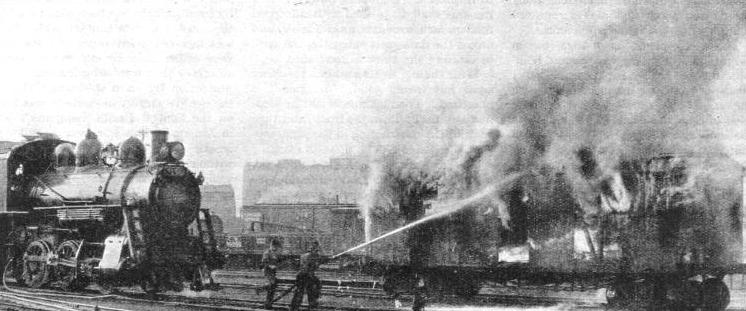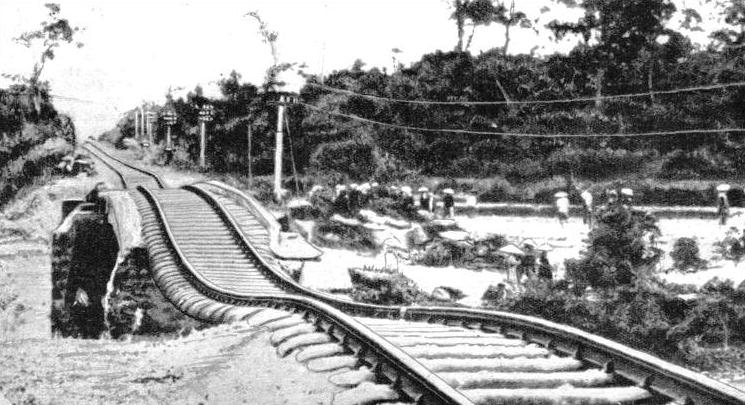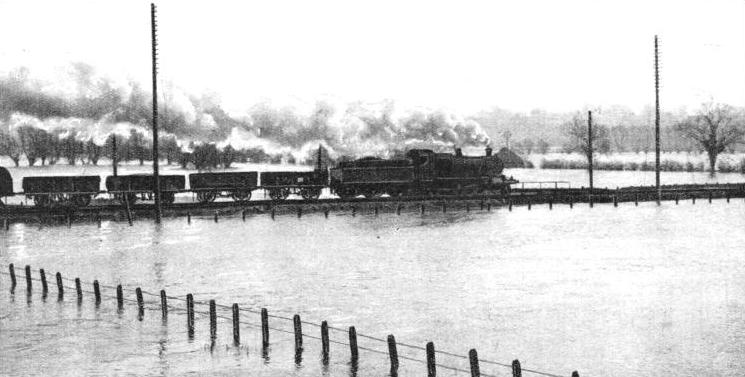
© Railway Wonders of the World 2024 | Contents | Site Map | Contact Us | Cookie Policy


Floods, Fire and Earthquake
The Railway’s Unceasing Battle with the Forces of Nature

FIRE-
ALTHOUGH the railway has scaled mountains, spanned gorges andcanyons, crossed deserts, burrowed under streets and run for miles over open sea, Nature is always striving to impede its progress and break the iron links that girdle civilization. It was the work of heroes to construct the railways. The maintenance of them, and the continuous battle against the threat of sudden disaster, call for courage and determination almost equal to that which enabled the constructors of the great trans-
Snow is the railway’s most common enemy. In countries where falls are frequent -
The snow-
Snow-
Avoiding the Avalanche
The contour of the ground on either side of the line has to be taken into consideration; should the ground rise up again there is a possibility of the slide falling back on to the track on the far side after it has passed over the shed.
One form of avalanche defence provides a simple means of throwing the snow clear of the line. On the mountain side a wall of heavy rock is built to support massive baulks of timber which are so laid that they point upward over the track. The lower ends of these timbers are buried, and the ground is dug out to form a hollow. The descending snow, rushing into the depression and up the inclined plane provided by the timber baulks, flies off into the air clear of the track. The snow-
A scudding, whirling snow-
The oldest and most common type of snow plough is in the form of a large wedge or double scoop, with a sharp prow, and is known as a wedge plough. This type is used only in those districts where the fall is relatively slight, and is not packed tightly.
It is operated by simple methods. The pointed nose of the plough is driven into the drift or bank, and the snow that is displaced by the prow is deflected along each side of the scoop and flung clear of the track. The snow, which may have banked high after drifting, does not always yield readily to the plough being pressed steadily forward. The machine then backs along the cleared track and makes repeated charges until the bank is overcome.

AFTER THE TYPHOON. One of the worst dangers facing mankind in tropical countries is the destructive typhoon, a raging wind which often tears away bridges and sweeps great masses of water against the railway viaducts. The scene above depicts what was once a normal stretch of line in French Indo-
The wedge-
Now and again obstructions will be met, and, unless the operators are fortunate, trouble follows. Sometimes a plough will be derailed, but it is usually the knives which suffer. There is a heavy sudden jolt, and if the obstruction is a boulder or a large tree-
With the big drifts and banks, where snow has frozen solid, “backing” is practised. The machine, with the locomotives, backs down the track, and then charges the obstruction in the same way that the wedge plough does its work.
The pressure is maintained until the machine drives its way through the packed mass, or is compelled to acknowledge defeat. In that event, there is no alternative but to revert to manual labour -
Menace of the Waters
On steep mountain gradients the struggle between the railwaymen and the forces of nature is experienced to the full. Four or five powerful locomotives, the rims of their smoke-
Belching steam and smoke, and with the plough completely out of sight, though betrayed by the fountain of snow spouting high in the air, the great engines clear a deep, square-
On many modern railway systems much of the work formerly undertaken by snow-
A second and equally relentless enemy of the railway is the flood, the devastating effects of which are relatively little known in the British Isles; but floods are only too familiar in other countries, such as India. Here the task of the railway engineers and bridge-
At some seasons the current whirls furiously along, and as the banks are mostly low and easily broken, the rivers frequently overflow, demolishing everything in their path. Should a railway embankment stand in their way, it is breached.
A river sometimes alters its whole course, and bridges are then left high over a dry river bed. During the flood season a river may overflow beyond its banks to the extent of three or four miles. When the water recedes to normal level it leaves behind long reaches of desolate sand.
To throw a bridge across such a river at a point where floods are prevalent is not only costly, but is also an enterprise which bristles with difficulties, owing to the instability of the constantly inundated low-
The method of controlling rivers is effected by means of a “training bund” -
These artificial works must be of immense strength to resist the enormous pressure and insidious scouring action of the swollen river. Large gaps are frequently made in the embankments by floods, with the result that the rails, with most of the sleepers still intact, are found draped across the breach like a graceful festoon. To restore traffic temporarily the engineers frequently have to erect trestle bridges.
Fire is the most terrible of all threats to the railway. Raging sometimes for days and nights in the dense forest regions, such as Canada and Western America, fire will reduce acres of growing timber to charred stumps and ash.
Where there is dry snow-
Fighting the Flames
To reduce losses to a minimum snow-
Forest fires and avalanches would seem to have little in common, yet, since they weaken and kill the roots of trees, fires are frequently the forerunners of the dangers caused by avalanches.
To guard against the havoc of fire, water-
Where railway lines are laid through forest lands the track has to be constantly patrolled, and in the summer, when fires occur more often, the patrols are increased. To combat a large fire the lines of the section are taken over temporarily to convey the fire-
Besides fire, flood and snow the railway has other enemies in tropical and semi-
That man is slowly but surely winning this grim battle with Nature is proved by the fact that the railway still carries on. The fiercest forest fires and worst floods, although they may temporarily hold up the traffic, must not paralyse the vital arteries of international communication, and cannot defeat the ingenuity and courage of the railway engineer.

RISING FLOODS imperil the railway track. This picture shows the vast extent of a Thames-
You can read more on “Avoiding the Avalanche”, “Clearing the Line” and “Floods, Fire and Earthquake 2” on this website.